#stump excavation
Explore tagged Tumblr posts
Text
Advanced Stump Removal in Battle Creek: The Key to a Clean and Safe Landscape
While many people aim for a safe and visually appealing property, tree stump removal is often overlooked. Stumps are unsightly and can be dangerous and an invitation for pests on your compound if not removed. If you have a stubborn stump that is old or ugly, you require professional services in stump removal to do the work effectively. At 269 Tree Removal, we pride ourselves for being the best and most experienced company in stump removal in Battle Creek that will ensure your property is clean, safe and ready for any form of development.
Why Is Stump Removal Important?

In addition to being unsightly, the stump left behind after tree removal can become much more than that. Over time it can develop several issues, hence the need for professional stump removal. Here’s why removing stumps is so essential:
1. Preventing Hazards
If the stumps are left standing in the ground they pose a lot of danger to children or old age people who are likely to fall over the stumps. They can also cause a problem with lawn equipment like mowers if not eliminated fully. When you opt for stump excavation services, you eliminate such possibilities and give your family or business a safer ground.
2. Avoiding Pest Infestations
These stumps I have seen are habitats to pests such as termites, ants, beetles, and other insects that move to healthy trees nearby or to your home. In regard to professional stump removal you reduce the chances of pests invading your property and further degradation by wood consuming insects.
3. Improving Aesthetic Appeal
It is very embarrassing to wake up to a well maintained yard only to find a monster old stump that was never moved. This alone offers new opportunities for landscaping such as planting new trees, setting up of flower gardens or even expanding the size of the lawns. Some of the most specific stump removal Battle Creek services not only remove the stump but also level the ground for other purposes.
4. Preventing New Tree Growth
Sometimes it is an issue that trees can grow back from the stumps. These suckers can grow very fast and end up becoming a number of small trees around the original stump which is a lot of work to get rid of. Proper stumping removes the roots therefore there will be no regrowth and you will not need to invest a lot of time and effort in future.
Our Advanced Stump Removal Process
At 269 Tree Removal, we use the latest equipment and techniques for stump excavation to ensure the most efficient and thorough removal of stumps. Our process includes:
1. Assessment and Inspection
In any stump removal project, we first establish the size, location, and type of stump to decide on the right removal technique. These include the age of the stump, the distance from structures, and the depth of the roots which determines the approach we take.
2. Stump Grinding
Stump removal is one of the most effective methods residents use to eliminate advanced stumps in Battle Creek. With the help of the specific equipment, we cut the stump beneath the ground level, and the land becomes suitable for the new planting. This process causes little or no harm to neighboring structures and is favorable to the environment.
3. Stump Excavation
In the cases of greater or more complicated stumps, stump removal may be necessary. Such a process implies the complete removal of the stump together with its root system. Although, more time consuming this process guarantees that no roots are left and, as a result, there is no possibility of regrowing or pests coming. Sylviculture is usually required for stumps close to foundations or driveways, depending on the local state laws.
Benefits of Choosing 269 Tree Removal

When it comes to stump removal in Battle Creek, residents should know that we at 269 Tree Removal are here to deliver the best services. Here are some reasons to choose us for your stump removal needs:
1. Expert Knowledge
Our team of professionals understands that there are different stump sizes and thus we are capable of handling any of them. We know the local soil conditions, tree species, and the difficulties that accompany different sorts of stump grinding, which allows us to do the work right the first time.
2. Advanced Equipment
In this line of service, we ensure that we use proper tools and equipment to ensure that we deliver efficient stump excavation services. Thanks to our up-to-date tools, we can easily perform the work and at the same time do not harm your lawn and plants.
3. Customer-Centered Approach
At 269 Tree Removal, our clients are our main focus. In our case, we communicate with the clients from the moment they approach us for consultation to the time they complete the project with them. We are always ready to provide clarifications about the process if you have any questions.
4. Eco-Friendly Solutions
We work hard to employ eco-friendly techniques to remove stumps from your compound and surroundings. We manage waste material well and are always sensitive to the environment in the course of providing services. Our goal is to make sure that your property is in even better condition after we are done and cause least harm to the environment.
#stump removal#tree services#stump grinding#landscaping#Battle Creek#tree stump removal#eco-friendly#professional tree removal#stump excavation#property safety
0 notes
Text

All Markly Sparky Markle Sparkles
Happy Holidays (Merry X-mas)
Beware of Santa Clause (Satan Claws)
Purchase you en-riched
Thee intrepid
Welcome a New Year
MMysbsdrow
wordsbyMM
That’s a tree • Not a dandelion
Picture • Not in horizontal
#wordsbymm#Markle sparkle#mmybsdrow#thoughts#words#none dandelion#that tree#spilled words#leaking words#unpicked up words#wordsbymm||mmybsdrow#cut at the stump#dig excavate#war machine#vent#flowing venting#breathe easy#second hand
0 notes
Text
THE IMPORTANCE OF PROPER PROPERTY GRADING
Having a well-maintained and visually appealing property is every homeowner’s dream. Proper property grading plays an essential role in achieving this goal. Property grading refers to leveling or sloping the land around your home to ensure adequate drainage, prevent water damage, and promote landscaping health. In this blog post, we will explore the importance of proper property grading, how it can prevent water damage, manage surface water drainage, mitigate erosion risks, and enhance the value and appeal of your property. Keep reading to learn why you should consider proper property grading for your home.
UNDERSTANDING PROPERTY GRADING
Regarding property development in Independence, Louisiana, understanding property grading is crucial for a successful project. Property grading refers to the shaping and leveling of the land to create a desired slope and contour. In this area, where heavy rainfall and potential flooding can occur, proper grading is vital in preventing water damage and managing surface water drainage. Proper grading safeguards your property from potential foundation issues and structural damage by directing water away from structures and towards designated drainage areas.
Moreover, proper property grading in Independence, Louisiana, is essential for mitigating erosion risks. With its susceptibility to erosion due to heavy rainfalls and the area’s topography, improper grading can exacerbate erosion and lead to soil loss and even landslides. By implementing effective grading techniques, property owners can minimize erosion risk and protect their property from erosion-related damage. Additionally, proper grading enhances the aesthetic appeal of your property and adds value to your investment, showcasing thoughtful planning and attention to detail.
PREVENTING WATER DAMAGE
In Independence, Louisiana, proper property grading plays a vital role in preventing water damage and ensuring the longevity of structures. Water can accumulate around foundations, basements, and other areas without adequate grading, leading to potential damage and costly repairs. However, by implementing proper property grading techniques, property owners in Independence can effectively redirect water away from their structures, safeguarding against water-related issues and maintaining the integrity of their properties.
Proper property grading is paramount in Independence, Louisiana, to prevent water damage. The region experiences heavy rainfall, and water can accumulate around foundations without adequate grading, posing a significant risk to structures. Water seepage into foundations can result in cracks, moisture problems, and even structural damage over time. However, by employing proper grading techniques, property owners can ensure that water is directed away from the property, minimizing the chances of water-related issues and protecting the longevity of their structures. With the proper slope and contour, water is channeled towards designated drainage areas, keeping properties in Independence dry and structurally sound.
In addition to protecting structures, proper property grading in Independence, Louisiana, also plays a crucial role in preventing surface water damage. With heavy rainfall and potential flooding, adequate surface water drainage is essential. Water can pool in low-lying areas without proper grading, creating mud pits or stagnant pools. This not only diminishes the property’s aesthetic appeal but also poses safety hazards and restricts outdoor activities. However, by implementing proper grading techniques, property owners can ensure that water flows smoothly and is directed to appropriate drainage systems, keeping their properties safe, dry, and usable. Proper property grading is an investment that protects properties in Independence from water damage and enhances their functionality.
MANAGING SURFACE WATER DRAINAGE
Managing surface water drainage is crucial to proper property grading in Independence, Louisiana. Ensuring efficient water flow is essential with the region’s propensity for heavy rainfall and potential flooding. Proper grading techniques allow property owners to channel water away from structures and low-lying areas, reducing the risk of water accumulation and damage. By implementing effective drainage systems and reshaping the land, property owners can create a safe and usable space, even during periods of heavy rainfall. Additionally, proper surface water drainage enhances the property’s aesthetic appeal by preventing the formation of mud pits or stagnant pools. With a well-managed drainage system, property owners in Independence, Louisiana, can enjoy their outdoor spaces without worrying about water-related issues and ensure a visually appealing environment for themselves and their guests.
PROMOTING LANDSCAPING HEALTH
Proper property grading plays a vital role in promoting landscaping health in Independence, Louisiana. By understanding the significance of grading and implementing it correctly, property owners can create an environment that nurtures healthy plants and vibrant greenery. Fine grading prevents waterlogged soil, which can suffocate plant roots and lead to their demise. Additionally, proper grading helps distribute water evenly across the landscape, ensuring that all areas receive the required moisture for optimal growth. By prioritizing landscaping health through good property grading, residents of Independence can create a visually stunning and flourishing outdoor space that enhances the overall appeal of their property.
Furthermore, landscaping health is crucial in Independence, Louisiana, where the local climate and soil conditions can pose unique challenges. With proper grading, property owners can address these challenges effectively. By shaping the land to promote drainage and prevent water accumulation, accurate grading minimizes the risk of water-related issues, such as soil erosion or water damage to structures. This, in turn, allows plants to thrive without being overwhelmed by excess moisture or deprived of essential water. Ultimately, by promoting landscaping health through proper property grading, residents of Independence can create a sustainable and beautiful landscape that withstands the local environmental conditions and adds value to their properties.
MITIGATING EROSION RISKS
In Independence, Louisiana, proper property grading is crucial in mitigating erosion risks and protecting your property from potential damage. Whether caused by natural factors or human activities, erosion can lead to soil loss, gullying, and even landslides. By implementing effective grading techniques, you can significantly reduce the risk of erosion and ensure the stability of your property.
Improper property grading exacerbates erosion risks, as it fails to control water flow and adequately distribute it across the land. With proper grading, the ground can be shaped to minimize runoff and redirect water to appropriate drainage systems. This helps prevent soil erosion and reduces the chances of structural damage. By investing in proper property grading, you can safeguard your property in Independence, Louisiana, and enjoy knowing your land is protected from erosion-related issues.
ENHANCING PROPERTY VALUE AND APPEAL
Regarding property development in Independence, Louisiana, one aspect that should be considered is the importance of proper property grading. Accurate property grading plays a significant role in enhancing property value and appeal. Property owners can create a visually appealing landscape by shaping and leveling the land while ensuring functionality and minimizing the risk of damage.
Proper property grading in Independence, Louisiana, offers numerous benefits that contribute to the overall value of a property. Firstly, it showcases thoughtful planning and attention to detail, which attracts potential buyers. A well-graded property stands out, creating a positive first impression and increasing curb appeal. Secondly, proper grading ensures water is directed away from structures, preventing water damage and foundation issues. This protects the property’s longevity and gives potential buyers peace of mind knowing that the property has been built with care and consideration for long-term durability. By investing in proper property grading, property owners in Independence, Louisiana, can significantly enhance the value and appeal of their properties, making them more desirable in the real estate market.
1 note
·
View note
Photo
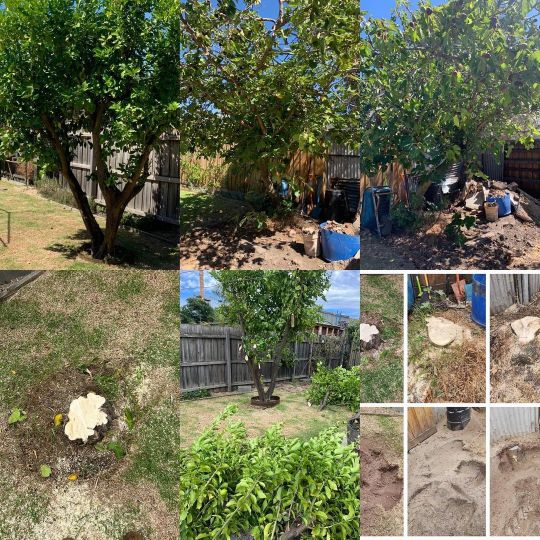
#propertycleanup #landscapeready #gardencleanups #gardencleanout #propertycleanout #gardencleanouts #treeremoval #stumpgrind #stumpgrinding #treecutting #arborists #excavation #excavator #excavationlife #excavators #excavationwork #fyp #stumps #paving #viral #hedges #pruning #retainingwalls concreting #concrete (at Coburg, Victoria, Australia) https://www.instagram.com/p/Cp6rtXuvtYG/?igshid=NGJjMDIxMWI=
#propertycleanup#landscapeready#gardencleanups#gardencleanout#propertycleanout#gardencleanouts#treeremoval#stumpgrind#stumpgrinding#treecutting#arborists#excavation#excavator#excavationlife#excavators#excavationwork#fyp#stumps#paving#viral#hedges#pruning#retainingwalls#concrete
1 note
·
View note
Text
A Guide To Know About Stump Grinder
What remains after a tree is cut down or when it naturally falls off? Stumps must be removed from the property, whether it's for safety concerns, aesthetic considerations, or because you need to plant or build something new. Although there are other options, stump grinders are the most effective ones. The stump is swiftly reduced to mulch that can be utilized in the garden, burned, or buried by the stump grinder.
Let's first define what a stump grinder is.
A powerful tool used to remove the stump from the ground is a stump grinder. It is also offered as a forestry skid steer attachment for a stump grinder. The size of stump grinders varies; tiny ones use gas, while huge ones use diesel and petrol.
What is the operation of the stump grinder?
Stump grinders tear wood as they rotate by using strong, revolving blades. The wood is divided into tiny pieces by the blade. The stump wood is chewed away by the stump grinder until it touches the ground or, occasionally, even lower.
Varieties of stump grinders: Little operations can be completed using lightweight grinders, whereas large jobs require heavy-duty grinders and complicated logistics. You may also search for grinders like the excavator stump grinder that is harsh on the stump yet gentle on your tractor. The various varieties of stump grinders include:
Hand-operated, behind-the-scenes, or "handlebar" grinder
Wheeled stump grinders with a hitch
Motorized grinders
Stump cutters for skids
A stump-grinding accessory
What advantages do grinding stumps offer?
The stump may naturally diminish, but this process can take months. Also, it's possible that the stump will begin to regenerate. The issue persists even if you bury the stump with soil or compost. The honey fungus frequently infects other plants and spreads. And it goes without saying that the large stump on your lawn or garden detracts from its charm. The greatest remedy to all of these issues is stump grinding.
Are you also searching for a mulcher, stump grinder, or any other land-clearing tools? Fecon offers several stump grinders and mulchers for sale, or there are many skids steer attachments. Create something fresh and beautify your land.
View original source - https://feconllc.blogspot.com/2023/03/a-guide-to-know-about-stump-grinder.html
0 notes
Text

July 23, 2024 - Olive-backed Woodpecker (Gecinulus rafflesii) Found in parts of Indonesia, Brunei, Malaysia, Myanmar, Thailand, and Singapore, these woodpeckers live in lowland and hill forests and mangroves. They eat ants and termites, foraging alone and in pairs on fallen logs, trees, saplings, snags, and stumps. Breeding from March to May, as well as October in Borneo, pairs excavate nests in trees. Both parents incubate the eggs. They are classified as Near Threatened by the IUCN as their population is declining due to habitat loss.
#olive-backed woodpecker#woodpecker#gecinulus rafflesii#bird#birds#illustration#art#tropical#birblr art
75 notes
·
View notes
Text
I found some garden treasures today!
I finally got this big green planter out of the sketchy garage attic recently, and got around to using it today, but first I had to excavate the crap that was in it, which included this antique copper (or some manner of copper alloy) watering head, and shards of painted pottery (these are too cute and will be going on the ancestor shrine).

Then as I was digging a hole to plant wild ginger near the old lilac stump, I noticed half a walnut shell tucked under its root. I pulled it out and flipped it over and discovered a teeny tiny baby snail! Then I put it back where I found it.

The wild ginger got a protective rock circle, mostly to protect it from my mother, who very kindly offered to come over and help with weeding last year, and ended up very thoroughly removing the previous wild ginger, which was just starting to spread.

Earlier today when I was at the community garden I met this cat. It wasn't interested in letting me pet it, but I was able to entice it into playing with a piece of grass with me. This is a tried and true cat befriending technique of mine.

37 notes
·
View notes
Text






Nipper and His Master’s Voice
The famous Nipper picture as revised for the Gramophone Company, from an oleograph
For much of the 20th century, one of the world’s most famous trade marks was a picture of a small terrier staring into the brass trumpet of a primitive gramophone. “His Master’s Voice” read the caption.
The picture was painted, probably in 1898, by the Huguenot artist Francis Barraud; the dog, ‘Nipper’ (he tended to nip people’s legs), had belonged to his elder brother Mark but was inherited by Francis on Mark’s death. Nipper himself had died, in 1895, before the picture was painted. Originally, the dog was shown listening to a cylinder phonograph, on which the user could record his own voice; thus, Nipper could have heard the voice of his master emerging from the trumpet. As Gramophones played only pre-recorded discs, a dog could hear only a master who happened to be a recording artist.
The story goes that Barraud offered his picture to the Edison Bell company (responsible for the phonograph in question), but they rather sniffily turned their nose up at the idea. Then a friend suggested that Barraud improve the picture with one of the brass horns used by the new Gramophone Company, so the artist approached them at their offices in Maiden Lane, off the Strand, for the loan of a brass horn to copy. “Yes, certainly”, was their response, “and if you replace the phonograph with a Gramophone, we will buy the picture.”
The Gramophone Company took delivery of the revised picture in October 1899; they paid Barraud £100 (£50 for the painting and £50 for the Copyright). Barraud had copyrighted the original painting in February 1899. No one knew what sort of phonograph was in that picture, until in 1972 the late Frank Andrews, of the City of London Phonograph & Gramophone Society (CLPGS), realised that Barraud’s copyright application would have been accompanied by a photograph. Searching through a box of applications in the Public Record Office in Chancery Lane, he found that photograph, showing the dog in front of an Edison Bell phonograph with a rather ungainly black horn. An illustrated booklet was published in 1973, The Story of ‘Nipper’ and the ‘His Master’s’ Voice Picture, written by Leonard Petts, then archivist at EMI, with assistance from Frank Andrews.
Francis Barraud talked of how “It suddenly occurred to me that to have my dog listening to the phonograph, with an intelligent and rather puzzled expression, and call it ‘His Master’s Voice’, would make an excellent subject” but recently two possible sources for the title, at least, have been put forward in For the Record,* the journal of the CLPGS. In 1888 a painting was exhibited by Sir William Orchardson called Her Mother’s Voice. It is in the Tate Gallery, a typical Victorian narrative picture of a widower listening to his daughter singing and reminding him of her mother. A more probable source is an engraving which appeared in the magazine Black & White in 1891, of a scene in which members of the Browning Society listened, a year after the poet’s death, to a recording of his voice. It was captioned ‘Listening to the Master’s Voice’. Barraud is likely to have been aware of this scene (its title might in turn have been inspired by the Orchardson picture). (*FtR 52, 2014 and 76, 2020)
In 1950, a party from EMI, with two members of the Barraud family, went to a courtyard in Kingston-upon-Thames where it was said that Nipper had been buried. Excavations near the stump of a mulberry tree in what was now a garage parking area revealed no bones that could be definitely identified as those of Nipper, but the site, then behind a bank, is widely regarded as Nipper’s resting place.
The picture, without its title, was registered by The Gramophone Company as a Trade Mark in December 1900 (it had been registered in the USA in July by Emile Berliner, the inventor of the Gramophone). In later years, up to his death in 1924, Francis Barraud was engaged to paint copies of the picture for the Company’s various offices; the original remained in the EMI boardroom for many years, and close inspection shows the pentimenti where the phonograph was overpainted. The picture was reproduced in Gramophone Company publicity from the outset, but did not replace their existing ‘Recording Angel’ trade mark. In the USA, the Victor Talking Machine Company, which was affiliated to the Gramophone Co, made more use of it as a trade mark. The two firms divided the world between them (Victor supplied the Americas and Far East; Gramophone supplied Europe and the British Empire apart from Canada) and thus Nipper and the Gramophone became a worldwide emblem very quickly. Ultimately, it was the British company which used it most prominently, for when a court decided in 1910 that the word Gramophone was no longer a proprietary name, the company registered the picture with the title ‘His Master’s Voice’ and the title alone as Trade Marks. ‘His Master’s Voice’ then became their brand name. It was a clumsy epithet, but public usage soon abbreviated it to HMV, as eventually, after WW2, did the company.
Take-overs, sell-offs and globalisation of products caused EMI to drop the Nipper trade mark by the end of the 20th century, and it was sold to the newly independent HMV shops in 2003.
The famous Nipper picture as revised for the Gramophone Company, from an oleograph
Nipper (photograph by Barraud, Liverpool and Oxford Street, London)
The original picture, with a phonograph, as shown in Barraud’s copyright photograph of 1899 (National Archives: Copy 1/147)
His Master’s Voice, cartoon by Victor Gillam, 1903; already, the picture was well enough known to attract a political cartoonist.
Blue plaque at 126 Piccadilly, London, the location of Francis Barraud’s studio in 1899
Nipper needle tins, 1902-1960; the embossed tin (top left) is the earliest, 1902-3. Top right is a cardboard packet from WW1, and bottom right, one of the many ‘clones’, mainly from overseas, trying to cash in on the dog’s popularity without infringing the trade mark
Copyright Christopher Proudfoot 12 March 2024 via huguenotmuseum.org

FRANCIS BARRAUD (1856-1924) English artist with a version of His Master's Voice painting which he originally completed in 1899
#classical music#opera#music history#bel canto#composer#classical composer#aria#classical studies#maestro#chest voice#Nipper#dog#His Master’s Voice#the Gramophone Company#Francis Barraud#classical musician#classical musicians#classical history#opera history#history of music#historian of music#musician#musicians#diva#prima donna#history#painter#painting
17 notes
·
View notes
Text

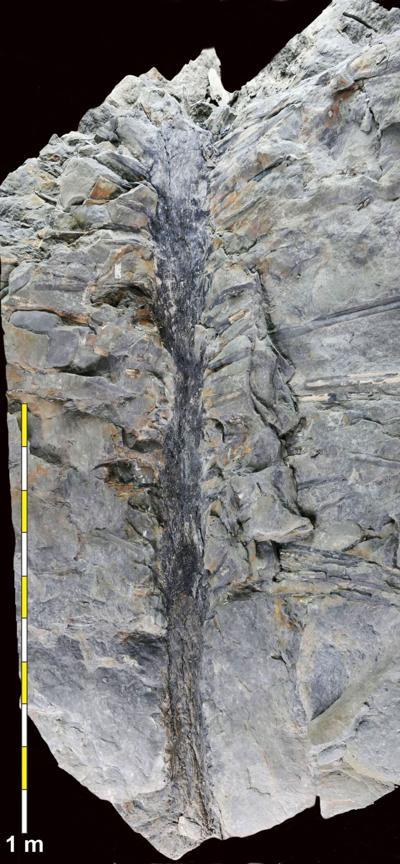
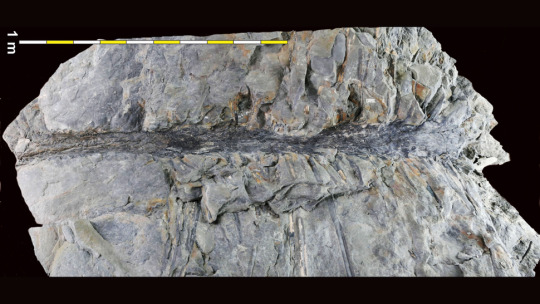
Rare 350 Million-Year-Old Tree Fossils Has Scientists ‘Gobsmacked’
Rare tree fossils preserved with their leaves have an architecture unlike any plant known today and represent the earliest evidence of smaller trees growing beneath the forest canopy.
Trees are believed to have originated hundreds of millions of years ago. Ever since, evidence of these ancient plant sentinels has been in short supply.
Now, a new discovery of uniquely 3D tree fossils has opened a window into what the world was like when the planet’s early forests were beginning to evolve, expanding our understanding of the architecture of trees throughout Earth’s history.
Five tree fossils buried alive by an earthquake 350 million years ago were found in a quarry in the Canadian province of New Brunswick, according to a study published Friday in the journal Current Biology. The authors said these new and unusual fossil trees not only bear a surprising shape reminiscent of a Dr. Seuss illustration, they reveal clues about a period of life on Earth of which we know little.
“They are time capsules,” said Robert Gastaldo, a paleontologist and sedimentologist who led the study, “literally little windows into deep-time landscapes and ecosystems.”
Coauthors Olivia King and Matthew Stimson unearthed the first of the ancient trees in 2017 while doing fieldwork in a rock quarry in New Brunswick. One of the specimens they discovered is among a handful of cases in the entire plant fossil record — spanning more than 400 million years — in which a tree’s branches and crown leaves are still attached to its trunk.
Few tree fossils that date back to Earth’s earliest forests have ever been found, according to Gastaldo. Their discovery helps fill in some missing pieces of an incomplete fossil record.
“There are only five or six trees that we can document, at least in the Paleozoic, that were preserved with its crown intact,” said Gastaldo, a professor of geology at Colby College in Waterville, Maine.
Most ancient tree specimens are relatively small, he noted, and often discovered in the form of a fossilized trunk with a stump or root system attached. For his colleagues to find a preserved tree that could have been 15 feet tall in its maturity with an 18-foot diameter crown left the paleontologist “gobsmacked.”
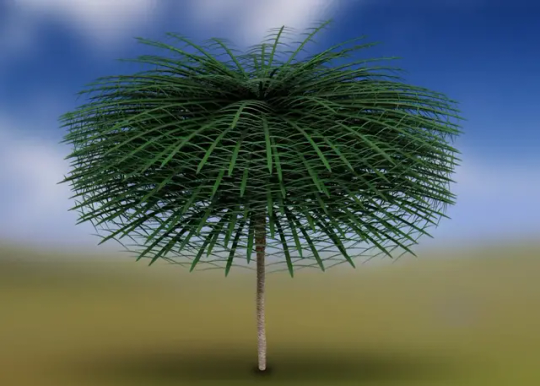

Ancient earthquake burial
The researchers excavated the first fossil tree about seven years ago, but it took another few years before four more specimens of the same plant were found in close proximity to one another. Dubbed “Sanfordiacaulis,” the newly identified species was named in honor of Laurie Sanford, the owner of the quarry where the trees were unearthed.
The forms taken by these previously unknown 350 million-year-old plants look somewhat like a modern-day fern or palm, per the study, despite the fact that those tree species didn’t appear until 300 million years later. But while the tops of ferns or palms as we know them boast few leaves, the most complete specimen of the newly discovered fossils has more than 250 leaves preserved around its trunk, with each partially preserved leaf extending around 5.7 feet (1.7 meters).
That fossil is encased in a sandstone boulder and roughly the size of a small car, according to Stimson, an assistant curator of geology and paleontology at the New Brunswick Museum.
The unique fossilization of the cluster of trees is likely due to a “catastrophic” earthquake-induced landslide that took place in an ancient rift lake, he said.
“These trees were alive when the earthquake happened. They were buried very quickly, very rapidly after that, at the bottom of the lake, and then the lake (went) back to normal,” Stimson said.
Finding complete fossil trees is rare and much less common than finding a complete dinosaur, according to Peter Wilf, a professor of geosciences and paleobotanist at Pennsylvania State University who was not involved with the study. Wilf noted via email that the “unusual” new fossil tree was a relic of a time period from which there are almost no tree fossils.
“The new fossils are a milestone in our understanding of how early forest structure evolved, eventually leading to the complex rainforest architectures that support most of Earth’s living biodiversity,” Wilf added.
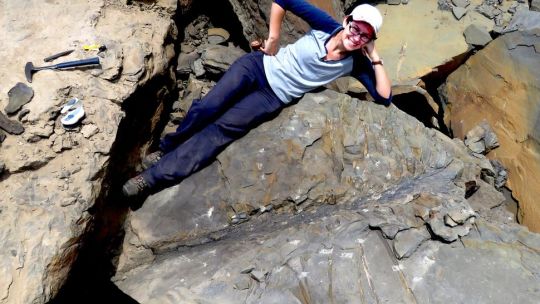
‘Very Dr. Seuss’
To King, a research associate at the New Brunswick Museum who found the group of fossils, the Sanfordiacaulis would have looked like something plucked straight out of Dr. Seuss’ most popular works.
“You know in ‘The Lorax,’ the trees have these big pom-poms at the top and narrow trunks? These probably have a similar structure. You have this massive crown at the top, and then it does narrow and paper into this very small trunk,” King said. “It’s a very Dr. Seuss-looking tree. It’s a weird and wonderful idea of what this thing could look like.”
But the reign of the Sanfordiacaulis was short-lived, the researchers said. “We do not see this architecture of plant again,” Stimson said. He noted that it grew in the early Carboniferous, a time period at the end of the Paleozoic Era when plants and animals were diversifying as they started to make their way from water to land.
Much of evolution is experimental, with success often measured by a species’ versatility, or ability to adapt to many different places and conditions. The peculiar set of tree fossils presents proof of a “failed experiment of science and evolution,” Stimson added. “We’re really starting to paint that picture as to what life was like 350 million years ago.”
Looking forward
Fossils such as the Sanfordiacaulis are not just useful in helping humans understand how life changed in the past, they can help scientists figure out where life on our planet might be headed next.
The existence of this particular species suggests that trees of the period were starting to occupy different ecological niches beyond what was previously understood, according to the researchers behind its discovery.
Gastaldo sees this as an indication that plants — much like early invertebrates — were experimenting with how they adapted to the environment. The earthquake that likely led to the trees’ fossilization also offers new geological evidence of what may have been occurring in Earth’s systems at the same moment in time.
“This is really the first evidence we have of (a tree) that would be between what grows on the ground and what would tower way above the ground,” Gastaldo said. “What else was there?”
By Ayurella Horn-Muller.
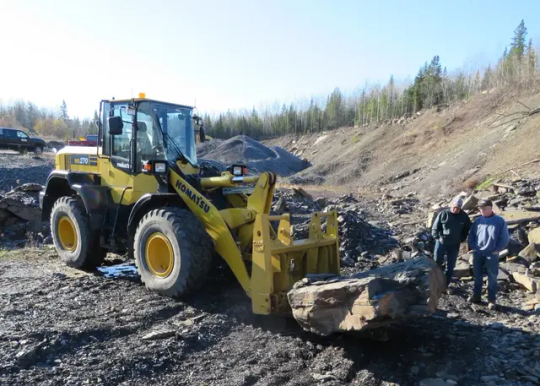
#Rare 350 Million-Year-Old Tree Fossils Has Scientists ‘Gobsmacked’#New Brunswick#Fossils#Tree Fossils#paleontologist#sedimentologist#geology#Sanfordiacaulis#archeology#archeolgst#history#history news#ancient history#long post#long reads
26 notes
·
View notes
Text
Cincinnati’s Old-Time Streetcars Were Notorious Death Machines
Cincinnati’s commuters have complained about mass transit since the first horse-drawn omnibuses started hauling passengers in 1859. By the late 1880s, the Queen City offered a selection of transport systems, from steam-powered inclines to equine-powered horsecars that struggled to ascend the city’s hills to a couple of cable-car routes on Vine Street and Gilbert Avenue. Each had its detractors.
It appeared that a new age dawned in 1889, when the Kilgour brothers introduced electric street cars as a replacement for horsecars and cable cars. The newfangled trolleys zipped up Cincinnati’s steepest hills, obviating the need to add auxiliary horse or mule teams on the steeper routes. The electric cars required far less maintenance than the cable cars that often, literally, froze up on icy winter days.
Despite their contemporary styling and innovative power systems, the new electric streetcars had one small but persistent drawback. They killed lots of people.
The years 1906 and 1907 were particularly bloody along Cincinnati’s streetcar lines. The Cincinnati Post [21 March 1907] tallied 22 fatalities caused by streetcars in 1906 and an additional 13 deaths in the first three months of 1907.
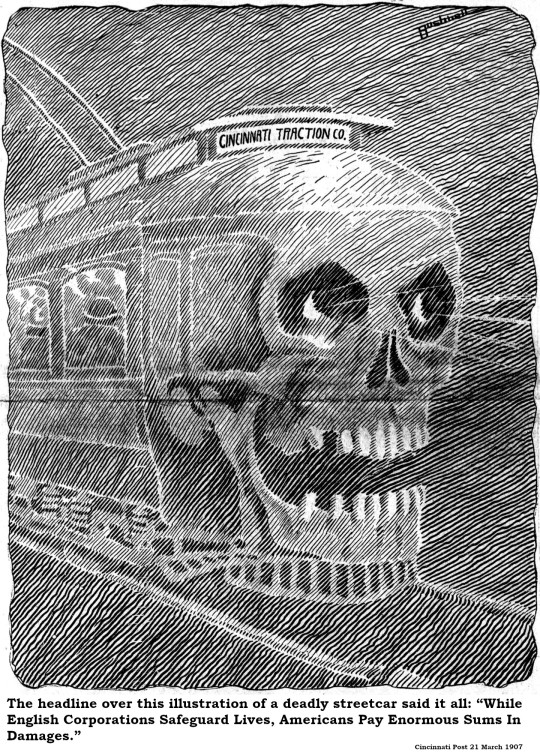
The Post’s report coincided with a national exposé titled “The Needless Slaughter by Street Cars” in the nationally distributed Everybody’s Magazine. Journalist and author John P. Fox slammed transit monopolies in cities across the United States for their dismal and deadly safety records. According to Fox:
“If along every mile of street railway track in the United States a headstone was raised for every death by accident the routes we travel would resemble one long drawn-out cemetery.”
Cincinnati’s death records and morgue records as preserved at the University of Cincinnati Archives support Fox’s contention. More than a hundred deaths between 1890 and 1910 are documented in these files as being caused directly or indirectly by street cars. There was 57-year-old Martha Fuchs, who died from injuries on 19 September 1908 after falling from a crowded streetcar. There was five-year-old Philomena Armenti, run over by a streetcar in 1906. And a physician, Dr. Edward Schaefer, 44 years old, who succumbed to injuries caused by a streetcar collision.
The streetcar companies and their employees regularly blamed the victims for carelessness. The Cincinnati Enquirer [1 September 1894] printed the complaint of a streetcar driver regarding pedestrians during rush hour:
“We don’t run 60 miles an hour, but you can kill a man just as quick at 12 miles an hour, and it shakes you up just as much. There isn’t a gripman but dreads to make the downtown loop during rush hours.”
And those were just the fatalities! Little Florien Bercheit was only five years old when he fell under the wheels of a streetcar. His legs were so mangled they were both amputated and he lived the rest of his years supported by crutches while dragging two wooden stumps along the streets. James Bennett, known as “Big Fiddle,” was a city street inspector, knocked by a passing streetcar into an open excavation in 1907 and paralyzed for life.
Fox’s exposé in Everybody’s Magazine blamed electric street cars in general, but the Post noticed that Cincinnati’s streetcars were far deadlier than those of cities of larger size.
“London is 14 times as large as Cincinnati, yet against the slaughter of 22 in Cincinnati, the biggest city in the world shows on its death roll that only 10 were killed by the surface street cars in 1906.”
According to the Post, Cincinnati’s death toll was the result of greedy traction companies interested in profit at the expense of human life and health.
“Traction companies prefer dividends to the saving of human life. They get fenders such as they use in Cincinnati, which have been declared humbugs by high railroad officials in the United States; they use primitive brakes; they employ inexperienced men; they drive competent motormen away from them by low salaries.”
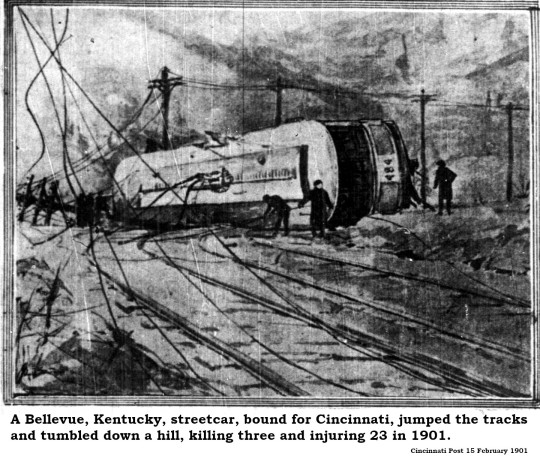
The quality of “fenders” or guards mounted around the wheels of the streetcar was a particular sore spot to the Post. Streetcar motormen involved in fatal accidents were routinely charged with manslaughter, but the Post found no record that anyone was ever convicted. Instead, the traction company lawyers placed the blame squarely on the victim and the courts never investigated whether better safety fenders or less-crowded cars could have prevented the death.
James Hall, driver on the Price Hill line, complained about the condition of his car when it left the garage on 30 December 1906 for its morning run. His supervisors ignored his observation that the brakes were faulty. Hours later, that car hurtled down Warsaw Avenue as motorman Hall lost control of the vehicle, his brakes entirely useless. The car, containing 38 passengers, accelerated until it reached a hairpin turn halfway down the slope and jumped the tracks, tumbling through the air into the side of the hill. Four people died and 20 were hospitalized. The runaway car crashed into a hillside covered in wet mud, which cushioned the impact and prevented even more fatalities.
Another major streetcar crash with multiple fatalities occurred when a Cincinnati-bound car jumped the tracks in Bellevue, Kentucky and tumbled down a steep hill on 15 February 1901. An inspector blamed the accident on morning frost making the rails at a tight turn too slippery. The transit company blamed officials in Bellevue and Newport for refusing to build a viaduct to bypass the dangerous turn.
Although big crashes made the headlines, most injuries and fatalities involved single individuals. In fact, the same edition of the paper that carried the news of the Bellevue accident reported the death of four-year-old William Crary of Baymiller Street. Attempting to cross the road, he was struck by a streetcar and “horribly mutilated.” Young William died en route to the hospital.
As automobiles became popular in the 1920s, they caused so many traffic deaths that Cincinnati’s abundant streetcar fatalities faded from memory.
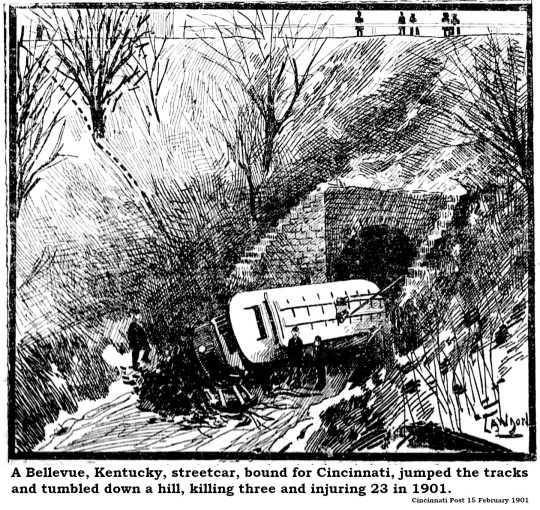
19 notes
·
View notes
Text
Reliable Tree Removal Services Orlando and Storm Debris Cleanup Orlando by Cox Arboriculture Services
Maintaining the health and beauty of your landscape is essential for any property owner. Whether you're dealing with tree health issues, planning a landscaping project, or need land cleared for new construction, Cox Arboriculture Services is your trusted partner for professional Tree Services Orlando and Land Clearing Orlando. With years of experience and a team of certified arborists, we provide reliable and efficient services that meet your specific needs.

Why Choose Tree Services Orlando?
Your trees are vital to the health and aesthetics of your property. However, over time, trees can become diseased, overgrown, or damaged, requiring professional care. Tree services Orlando from Cox Arboriculture Services provide a range of solutions that ensure your trees are healthy, safe, and looking their best.
1. Tree Trimming and Pruning
Proper trimming and pruning help maintain the structure and health of your trees. Our expert arborists in Orlando carefully trim dead or diseased branches, improving the appearance and longevity of your trees. Regular pruning can also enhance tree safety by reducing the risk of branches breaking during storms.
2. Tree Removal
Sometimes, tree removal is necessary due to disease, safety concerns, or space requirements. Our professional team provides safe and efficient tree removal services Orlando, ensuring that your property remains secure. Whether it's a small tree or a large, complicated removal, we have the expertise to handle it with precision.
3. Tree Health Assessments
Maintaining the health of your trees is crucial to preventing future problems. Our arborists perform thorough tree health assessments, identifying potential issues like pests, diseases, or poor growth. Early intervention can help keep your trees healthy and prevent costly removal or damage later.
4. Stump Grinding and Removal
After a tree is removed, the stump can remain an eyesore and a potential hazard. Cox Arboriculture Services provides professional stump grinding and removal, leaving your yard clean and free of any leftover debris.
Comprehensive Land Clearing Orlando Services
When it comes to preparing land for construction, landscaping, or development, land clearing Orlando is an essential service. Whether you’re clearing a lot for a new home, building, or creating a garden, Cox Arboriculture Services offers expert land clearing solutions that ensure your project starts on the right foot.
1. Tree and Shrub Removal
Before you can begin building or landscaping, the land must be cleared of any trees, shrubs, or other vegetation. Our team offers safe and efficient tree and shrub removal, carefully clearing the area while preserving the integrity of the surrounding landscape. Whether you need large trees removed or smaller vegetation cleared, we’ve got you covered.
2. Debris Removal and Cleanup
After land clearing, debris removal and cleanup are essential steps. We ensure that all logs, branches, and unwanted material are removed from your property, leaving the area clean and ready for your next project. Our cleanup services prevent any leftover debris from becoming a nuisance.
3. Land Grading and Excavation
Sometimes, land clearing isn’t enough. Our team also offers grading and excavation services to ensure your property is level and ready for building or landscaping. Proper grading can prevent drainage issues and improve the overall layout of your land.
4. Site Preparation for Construction
Our land clearing Orlando services are perfect for property developers or homeowners looking to build. We clear the land, remove trees and stumps, and level the ground, providing a clean, solid foundation for your construction project.
Why Choose Cox Arboriculture Services for Tree Services Orlando and Land Clearing Orlando?
At Cox Arboriculture Services, we are dedicated to providing top-notch tree care and land clearing services throughout Orlando and the surrounding areas. Here’s why you should choose us for your next project:
1. Experienced Arborists
Our team is made up of highly trained, certified arborists who have years of experience in tree care and land clearing. Whether you need help with tree health assessments, tree removal, or land clearing, we have the knowledge and expertise to get the job done safely and efficiently.
2. State-of-the-Art Equipment
We use the latest tools and equipment to ensure that every job is done right. From tree trimming and stump grinding to land clearing and grading, we have the right equipment to handle even the most challenging tasks.
3. Comprehensive Services
From tree maintenance to land clearing, we offer a full range of services to meet your needs. No matter the size or scope of your project, Cox Arboriculture Services can provide solutions tailored to your requirements.
4. Safety and Efficiency
Safety is our top priority. Whether we’re performing tree removal or clearing land, we take the necessary precautions to ensure that the job is completed without incident. We also pride ourselves on working efficiently to meet deadlines and keep your project on track.
5. Customer Satisfaction
We’re committed to providing the highest level of customer service. From your initial consultation to the completion of the job, we keep you informed and involved every step of the way. Our goal is to ensure that you’re completely satisfied with the results.
Conclusion
For all your tree services Orlando and land clearing Orlando needs, Cox Arboriculture Services is the trusted name in the industry. With years of experience and a commitment to quality, we offer reliable, safe, and efficient solutions for residential and commercial properties. Whether you're looking to maintain the health of your trees or clear land for a new project, we have the expertise to help you every step of the way. Contact us today to schedule a consultation and take the first step towards a beautiful, well-maintained property.

#Tree Services Orlando#Tree Removal Services Orlando#Tree Removal Orlando#Tree Trimming Services Orlando#Tree Trimming Orlando#Stump Grinding Services Orlando#Stump Grinding Orlando#Storm Debris Cleanup Orlando#Land Clearing Services Orlando#Land Clearing Orlando#Bobcat Services Orlando
2 notes
·
View notes
Text
Starve Acre (2023)

1970s folk horror bears a heavy mark on the lineage of the genre in the British Isles, and nothing seems to be trying harder in recent memory this side of Ben Wheatley to enter into that venerable canon. Down to the film grain and wardrobe choices this is on an aesthetic level that to a tee. Even more importantly, this film pairs a deliberate plodding pace with a sense of austerity and vacancy. Emptiness haunts this couple following the loss of their child, something which is at once harrowing and almost an easy out. Juliette and Richard are adrift after the death of their son, but given his troubled recent months, it’s something of a reprieve. As with Don’t Look Now or maybe Hereditary, the raw wound of recent loss proves the catalyst for other, more supernatural occurrences. This was an inevitable breaking point, pushed beyond the pale by the land and circumstance and lore. Mourning is part of the texture of the film, something at once utterly destructive and yet transformative. Jules and Richard’s child is supplanted by the excavated corpse of a hare, a skeletal figure that begins to spontaneously regenerate, much to Richard’s consternation. This new surrogate fills a void, in a sense, Jules finding something new and fragile to protect and care for. In the absence of it all, clinging to this symbol of something darker and older, caring for it, is gutting. But it’s entirely in keeping with this type of despair that we started to see in The Wicker Man and "Penda’s Fen" and the like: a disenfranchisement with authority, paired with the inherent symbolism of the old world and the cultural roots of the landscape. The final image of a broken family reunified in a damned sense fulfills that empty prophecy, that there is no hope.
Nature is red in tooth and claw, even for rabbits. The destruction of ancient practices might be an archaeological or anthropological tragedy, but for folk horror it’s just part of the stew. The recency may shock Richard’s colleagues, but paganism had deep roots, deeper than can be excavated, far beyond any purge could hope to quell. There is a tragedy, as with the family, to the destruction of nature in the name of stopping destructive practices, but there is a violence and a reprehensibility to the continuation of those practices which the modern era cannot contain. The moment the older woman wanted to start meditation, we knew she was bad news, but here we are with her worship of a long-buried stump. This is what In the Earth should have been.
THE RULES
SIP
Someone says 'Jack' or 'tree'.
Wind rustling through branches.
Low horizon landscape shot.
BIG DRINK
The rabbit changes.
Intense lens flare in a scene.
#drinking games#starve acre#daniel kokotajlo#morfydd clark#matt smith#horror#horror & thriller#folk horror#in the earth#penda's fen#hereditary#british horror
2 notes
·
View notes
Text
So I came across a question on TikTok.
“If you could describe yourself in one word, what would it be?”
Usually I write down simple things like odd, strange, weird, unique…etc. Yet this time I found myself stumped for some reason. Stumped by a question I thought I already had the answer to. As fitting as those labels were (and still are) I couldn’t bring myself to write them. So I just sat there…thinking inwardly for about 20 minutes and only one word kept coming into my brain…desperate.
I’m desperate to be wanted, loved, and needed. Desperate to be happy, safe, and healthy. Desperate to give those I love these feelings in return. Desperate to live, to learn, to experience it all. Desperate to be me unapologetically, desperate to feel more self worth, to be validated…desperate to exist.
It’s a strange sensation to I realize the desperation of your own soul when so long that feeling was buried deep in the reassesses of the dark places you refused to acknowledge. So deep it was forgotten. It’s only now that I realize just how far I’ve come. How easily it is to admit something that used to be so jarring. Jarring enough to bury entirely. Self care, shadow work, personal gnosis…these are the tools for such excavations. The years of time and effort put aside to go deep and uproot anxieties, face personal demons, and forgive old ghosts has not gone unrewarded. I feel that I’ve come to such a place of comfort with myself now. A place the old me would never had dreamed of reaching. On the surface I felt like I wasn’t making this much progress, but such a small and seemingly innocent query has opened my eyes. I see the path I’ve traveled so far, and while there’s still a long journey ahead, I’m so pleased with the distance I’ve covered.
I also feel I must state, that while I do have ancestors that assist me, spirits that guide me, and deity that teach me…I’m the one that still has to make the journey. I’m the one that had to decide to jump from the cliff side and plunge into the churning shadows below. Another important lesson I’ve learned…self recognition. It’s my power that’s gotten me this far. And while I’m incredibly thankful for all those behind me, I am finally at a good enough place with myself that I can recognize my own work for these endeavors.
I close this post in a much more pleasant state of mind. I can’t wait to see where this road takes me next.
#paganism#witchcraft#pagans of tumblr#chaos magician#chaos magick#witches of tumblr#eldritch magic#chaos witchcraft#death witch#shadow work#self love#self care#occultist#occult#occultism#witch
6 notes
·
View notes
Text
Since AO3 is still down and we’re all going feral over it, here: Have the first chapter of what would have been my Bottomji fic but got completely out of control
There is always something to kill, this close to the ruins of Nightless City.
The nighthunt itself began, if not routine, then at least not strange in ways that could not be explained. A rockslide nearly buried a small village at the edge of the mountains that border what was once Qishan, but the Nie sect reacted swiftly and skillfully. The villagers were rescued with minimal casualties, the survivors given temporary shelter, and Nie Mingjue was working quickly to help find long-term solutions for how and where the villagers will live, now that their home has been destroyed. Lan Wangji likely would not have come to help after his business in Pingyang concluded -- were it not for the startling influx of resentful creatures.
It is perhaps inevitable, in the wake of any disaster, that some resentful creatures will be drawn to the scene. This is why cultivators address mundane disasters in their territories to begin with -- an avalanche, drowning, or forest fire may technically be the jurisdiction of the local magistrate, but its immediate aftermath always brings work for a cultivator. Even for such a small number of deaths, and in such a remote location, a handful of gui and yao are to be expected.
What is not expected is the horde of gui, yao and guai that fell on the mountain like ants to a corpse, spilling out into the village below. Nie cultivators were forced to address the attacks rather than focus their attention on excavation, and more villagers suffocated or were crushed in the time it took to drive the creatures back.
Lan Wangji must stay and offer assistance. Xiongzhan will be unhappy at his late return, but it cannot be helped. The Nie are formidable. Their method of cultivation makes them uniquely suited to carving through large swaths of resentful creatures at a time, but they are still outnumbered, and worse, they are separated by necessity. The very fighting style that makes them able to stand in the midst of such chaos, forcing the outpouring of enemies to break around them like stream water parted by a boulder also makes them a danger to any allies who may stand too close. In the bedlam, the risk of accidentally striking and killing a friend is high.
So: Lan Wangji, steadily making his way up the mountain, using his qin to offer support to the Nie cultivators who cannot allow their own sect siblings close enough to defend them. The farther up the mountain he goes, the stranger the situation seems. Perhaps if the creatures’ ranks were made up primarily of human corpses, it would be explainable. A mass grave, disturbed by the rockslide, would account for the concentration of resentful energy in this specific area. However, the gui are few and far between. Most of the creatures they face are yao and guai; walking trees with grasping limbs and bloated, mutated forest critters, thrashing lengths of vine that have grown hungry mouths at their roots. There is something evil here, and it has been here for some time, soaking into the soil and drenching the air.
It is grueling work. From afternoon to dusk, they fight together to push back the horde. Lan Wangji alone can fight without his sword, and so he does, hovering on Bichen to weave between trees that occasionally attempt to snatch him from the air, plucking singing notes from his qin to lay down cover fire from above. For the most part, the Nie have the situation handled. He is here only to ensure that none of them die in the process. In this, he is successful, although blood is still spilled. Some of it is his.
They are never truly at risk of defeat -- although numerous, the creatures are not especially strong -- but Lan Wangji is nonetheless exhausted and worn by the time the killing is done. He has chased the last of the guai (a haunted tree stump, skittering on its roots like spider-legs) past the treeline and into a clearing before dealing the final blow.
The clearing itself is unremarkable; a pocket of space in the stifling density of the forest. The only thing of note is that there was a shrine here, once. It is rubble now, beaten down by the rockslide just as the village below had been. This alone is not strange. What is strange is the scattering of ward stones, now cracked and misaligned, that dot the clearing around the shrine. What is stranger still is the heavy wave of thick, cold resentment, pouring from somewhere in the ruins of the shrine.
Something had been sealed away here, and now it is not.
Lan Wangji weighs caution against necessity. It is possible whatever waits in the ruins of the shrine will be more than he can handle. His hands and fingers ache from the bite of his qin strings, and he has depleted enough spiritual energy that it would be unwise for him to try and fly home without resting for the night, but this is clearly the source of the outpouring of resentful creatures. If it is not addressed swiftly, more creatures will come. The village nearby has been evacuated, but this mountain is an important pass for travelers and merchants, and there are more villages. If the number of resentful creatures grows, it is unlikely they will all be found and dealt with before they can spread out and claim more victims. People will die.
Carefully, he approaches. There does not appear to be anything active within the ruins. He can sense no movement, and though it is hard to tell through the fog of resentment, he doesn’t believe he senses any killing intent, either. Whatever it is, it is leaking enough resentful energy to have poisoned this entire section of forest, but it does not appear to be doing so intentionally. A cursed item, then?
He uses Bichen to prod through the rubble, taking heed not to touch anything with his bare hands. There are more layers of broken wards, shattered in the avalanche. Eventually, he finds a box. It, too, was once carved with seals, and it, too, is broken. This is perhaps another strange thing. Whatever is in this box was very thoroughly sealed away. It is unlikely a mere avalanche would have been sufficient to destroy every single layer of protection surrounding it. Lan Wangji cannot say for certain what would have been sufficient, because the item the box contains has not been removed from the box, so it seems unlikely that the shrine was destroyed on purpose. Unless whoever sought to claim the item died in the attempt, and is now one of the few human corpses dotting the mountain?
Again, he uses Bichen to nudge aside shards of broken stone, at last revealing the artifact leaking resentful energy like water from a basket. He blinks. The face staring up at him blinks back.
The item is a mirror of polished bronze, gleaming the colors of the sunset overhead. There is a thin wrapping of chain and wire encasing it, yet another layer of seals, though Lan Wangji cannot fathom what might be left to seal, with the mirror pouring out so much resentment. Regardless, this last layer of protection is unbroken. He will take care to ensure it stays that way.
Nie Zonghui enters the clearing, wiping blood from one of his sabers. Lan Wangji explains his findings. There is a moment of discussion -- Qinghe is well equipped to store cursed items, but less equipped to neutralize them, and the sheer power radiating from this particular item would be better addressed than simply locked away, especially as that has been tried once, and already failed. Nie Zonghui helps Lan Wangji wrap the mirror in cloth, and carefully tuck it away in a qiankun pouch. They take rubbings of the remaining seals and ward stones to be examined later, as Lan Wangji’s knowledge in this field is too rudimentary to parse exactly what the wards may have been for. The Nie disciples do a final pass through the forest in search of any resentful creatures, and Lan Wangji plays several rounds of cleansing.
Some of the Nie attempt to invite Lan Wangji back to Qinghe for the night, in thanks for his assistance. He is offered mulled wine, then tea when the disciple is reminded by their sect-siblings that the Lan do not partake. He is promised food and an invitation to dice games to celebrate the day’s victory.
The Nie disciples cluster together. They throw their arms casually about one another’s shoulders. Many of them count heads, and visibly relax when the last of their companions make their way into the clearing. They tease and shove one another, grinning. The youngest whine at aching feet and empty bellies, and are laughingly scolded by their elders, even while field rations are passed around to tide everyone over until they can have a proper meal.
Lan Wangji would not be good company for such a group. Lan Wangji is very rarely good company for anyone. He politely declines. The Nie disciples insist on at least escorting him to the nearest available inn, the next town over, and because they are going the same direction to return to Qinghe Lan Wangji makes no attempt to refuse.
Despite the Nie reputation of brutishness and militarism, Lan Wangji has never known them to be lacking in hospitality. Even if he is only shown such regard because he is the younger brother of Lan Xichen, who is well known to be Nie Mingjue’s oldest and dearest friend. Nonetheless, he is reminded as they travel that there will always be a bed available for him in the Unclean Realm, and that the hot springs are his to use as he sees fit, should he choose to spend the night in Qinghe after all.
It is tempting, but to take advantage of their courtesy would mean locking himself (and them) in an uncomfortable pantomime of etiquette. Should he accept the offered bed, social obligation would dictate that he join their company for the evening, while they attempt to indulge in their drinking and dice games and he lingers awkwardly on the sidelines, intrusive and invading. He has no interest in such things, and they most certainly have no interest in his stilted attempts at socializing. He declines once more, and reassures Nie Zonghui that he intends to go promptly to bed and leave at first light, and as such, staying in the Unclean Realm would be both wasteful and disruptive. The Nie are stubborn as a rule, but Nie Zonghui has known Lan Wangji for most of his life; they have spent many a day quietly existing in one another’s presence. When Shufu visited the late Nie-Zongzhu and Xiongzhang visited Nie Mingjue, Lan Wangji and Nie Huiasang were typically shoved together, and Nie Zonghui was assigned to watch the younger boys. As such, he only sighs, nods, and bids Lan Wangji safe travels. Lan Wangji returns the courtesy.
This late at night, the main room of the inn is nearly empty. The owner, who had been all but sleeping at the desk, jerks sharply upright when Lan Wangji approaches to pay, and blinks sleepily through their transaction. The qiankun pouch will hold the mirror safely for the night, though Lan Wangji will have to hurry straight home come morning. In the still and quiet of his room at the small but serviceable inn, he bathes, and eats, and goes to bed.
Dawn brings with it a sense of urgency. The resentment from the mirror is leaking from the qiankun pouch -- only barely, so faint Lan Wangji had not noticed it until he was halfway through dressing for the day, but it is leaking all the same. He eats breakfast quickly, meditates for only as long as is necessary to ensure that his qi is circulating at acceptable levels after yesterday’s strain, and departs from the inn. He is in the air before the last colors of sunrise have faded from the sky.
He lands, once, for lunch and to play cleansing for the mirror. He does not linger.
Trouble does not arise until late afternoon, when he has already passed between the border of Lanling and Gusu. He is considering landing again -- he will make it to Cloud Recesses before curfew, but he would like to play another round of cleansing for the mirror before he arrives -- when the choice is taken out of his hands.
It begins with a prickle at the back of his neck. Instinct alone has him swerving sharply, tucking his chin to his chest as a bright and burning thing grazes past his head, close enough to feel the heat of it. He doesn’t get a chance to see what it was or where it came from -- there is another, forcing him to pull up sharply and clench his jaw through the wash of vertigo, and another which he barely avoids as he wrenches himself through the air, and then --
Pain.
The stink of burning silk.
Like a stone, Lan Wangji plummets.
What he sees, as he scrambles to tear off his burning robes and regain his footing on Bichen, is this: dead, human-like things that twitch and jitter. Their flesh is charred. Cracks where the burned skin has split show a deep orange glow, like an ember not yet coated in ash. If they at one time had discernable eyes or noses, that time has passed. Their faces have melted and blackened. Only their teeth remain in lipless mouths, ash-gray and chattering, occasionally revealing the scorched lump of their tongues. In the sky, among the fresh air, he had neither heard nor smelled them. On the ground, he can do both. They stink of burned meat. They move with the clicking and clattering of bone dice on a stone floor.
Lan Wangji has seen a great number of terrible things in his life, and has built a strong stomach in response, but there is something wrong with these creatures, in a way he can neither explain nor articulate. Something unnatural. There is a dull clenching in his gut, not-quite-nausea, as his instincts rebel against the very existence of these -- things.
Lan Wangji lands hard. Jerks to one side as one of the creatures throws another palmful of strange, sticking fire at him. Dodges back and back again.
They are, he learns quickly, fast. He spends a hundred breathless seconds dancing half-hazardly from burning blows, every frantic toe-tip step taking him away from one attack and towards another. The creatures pounce. Lan Wangji evades. At last he scrapes together the scant second he needs to call Bichen back to his hand.
They are, he learns quickly, durable. His first slash carves neatly through the chest of one of the creatures, cleaving through black flesh and charred bone. There are no organs inside, only the fireheart gleam of dying coals beneath the outer husk. Sparks fly from the wound to sting Lan Wangji’s hands and face, float drunkenly in the air. Burned flesh crackles like wood on a fire. Clicks itself back into place. The creatures gnash their awful stone teeth.
They are, he learns quickly, intelligent. His next blow jolts to a hard stop, Bichen wrenching in his hand as it’s caught -- first between black fingers and then between gray teeth, the creature thrashing to disarm him. A scorched foot snaps out, thuds heavily against his sternum hard enough that something cracks, sends him reeling back. The place the creature touched him burns.
When he drags in his next breath, it is choking-thick with smoke and resentment. The taste of blood lingers on the back of his tongue.
One of the creatures lunges for his abdomen, and Lan Wangji must again abandon his sword. The dance drags on.
It is a misstep that leads to terrible understanding. The place he has been attacked in is a stretch of dry, rocky land with sparse vegetation. He knows he is being driven onto unsteady ground, but he cannot find an opening to break free. Again and again, Lan Wangji must dodge back from grasping fingers. Again and again, he must seek footing on precarious piles of stone, or twist at the last second to avoid catching his foot in a deep groove.
It is perhaps inevitable that he eventually fails.
When he does, it is because he is forced to take uncertain footing to avoid yet another blow -- one which glances close enough to singe the skin of his ear. The stone gives out under him, sends him stumbling, and in that moment one of the creatures snatches the qiankun pouch from his belt and disengages from the fight, leaving the three others to continue their assault.
It opens the pouch with quick, clever fingers, the gesture sickeningly human in such inhuman hands. From the pouch, it draws the mirror.
The creatures give off heat like bonfires, but Lan Wangji feels himself go cold. There is much he does not understand, but this, at least, seems simple. Whatever these things are, and whatever that mirror is -- they cannot be allowed to have it.
The sun will soon set. He has his signal flares. He can send one up once it is dark, and hope it is seen by someone. Anyone.
In the meantime, he needs to retrieve the mirror.
The next blow is nearly perfunctory. Lan Wangji is no longer the main target, he has become a loose end, and so killing him is a lesser concern. That’s good. That will have to be enough.
Again, he throws himself to the side. Again, he is chased. Again, he forces his body to move.
A quick step, a moment of breathing space. He calls Bichen once more to his hand. She plunges through the chest of one of the creatures on her way back to him, and although the creature does not die, it slows.
He will make this be enough.
This time, he knows they will try and disarm him. He will not allow them to do so. One of the creatures jerks towards him and swiftly loses a hand. The other is sent to the ground with the force of his blow as he thrusts Bichen into its empty chest and heaves its body away from him. The creature holding the mirror makes an -- awful sound, a choking, rasping thing, a scream with no air or voice to shape it. It drops the mirror. Its fingers are crumbling to ash.
A hand closes around Lan Wangji’s ankle, dragging at him. He feels the scorching heat of it all the way through his boots. He stomps on the wrist of the grasping creature with all his force, and is gratified by the charred-wood crackling as it is crushed to nothing beneath his heel. Thus freed, Lan Wangji lunges.
He cannot kill them. Every blow he lands closes itself. Every limb he cuts off reattaches. Only the creature who touched the mirror seems at all properly injured, still hacking its terrible noises of distress. Its disintegrated fingers have not grown back. Lan Wangji would perhaps try to use this advantage, if only the mirror were not spewing more resentment than any living creature could feasibly withstand, clogging the air and limiting his vision. It sticks to his skin and in his mouth and down his throat and settles in his lungs and stomach. He wonders if this is what it feels like to drown. He wonders if the resentment will kill him before his core can destabilize, before he can qi deviate. He wonders how this all went so wrong, so fast.
He wonders if he will get to see Mother again. If she waited for him, or if she has already reincarnated.
Half-blind, he dives for the mirror. Feels the displacement of heat and air as the creatures follow. He lands first. They land on top of him.
Stone teeth, hot like a griddle, latch onto the meat of his shoulder. It is a pain that is difficult to describe, to be cut and torn and burned all at once. The press of the creature on his back is hot enough to blister his skin through all five layers of his robes. The mirror against his stomach is cold like frozen steel. It burns, too.
He wonders if Xiongzhang and Shufu will forgive him for not saying goodbye.
His core churns. His qi surges under his skin. He will have only one chance -- he is strong, and his strength will have to be enough. One great blast of spiritual energy. At worst, it will be felt all the way in Cloud Recesses and that will be as good as a signal flare. Perhaps there will be something left of his body to be buried. Perhaps the mirror will be retrieved.
Lan Wangji coils his qi tight in his chest, gets ready to push --
The resentment spikes, trembles, and crashes over him like a Yunmeng storm. The shock of the cold freezes him solid, leaving him gasping through stiff lungs. Winter itself settles in his marrow.
Then, just as quickly, spring returns. He thaws.
He is surrounded by piles of ash, and he is alive.
He is alive?
Lan Wangji breathes. Raises a hand to feel his pulse point. His heartbeat is erratic, but it exists.
He is alive.
Dazed and dream-like, Lan Wangji rises slowly to his knees. His body hurts. His meridians ache in peculiar ways, likely damaged from what he just tried to do to them. He is very certain he is not dead, but in the strange, hazy headspace he’s found himself in -- dizzy and disbelieving, exhausted and, paradoxically, strangely exhilarated -- he’s not entirely sure he is conscious.
He sees, now, what caused the creature’s fingers to crumble to dust. The final layer of protection, the delicate lace of wires and chains, has been torn away from the mirror. It is unclear whether the seal was broken by the creature or by the spirit within the mirror.
Because there is undoubtedly a spirit within the mirror. The face peering up at Lan Wangji is not Lan Wangji’s own. The face is sharp-featured and handsome, clever silver eyes and a feline grin.
The man in the mirror points that grin directly up at Lan Wangji. “Aiyah,” he says, half-laughing. “That was close! Are you alright, Lan-gongzi?”
#MDZS#The Untamed#Lan Wangji#Wei Wuxian#Wangxian#Dark fairy tale AU#this will eventually be wangningxian#but in this chapter its just lwj and wwx at the very end
17 notes
·
View notes
Photo
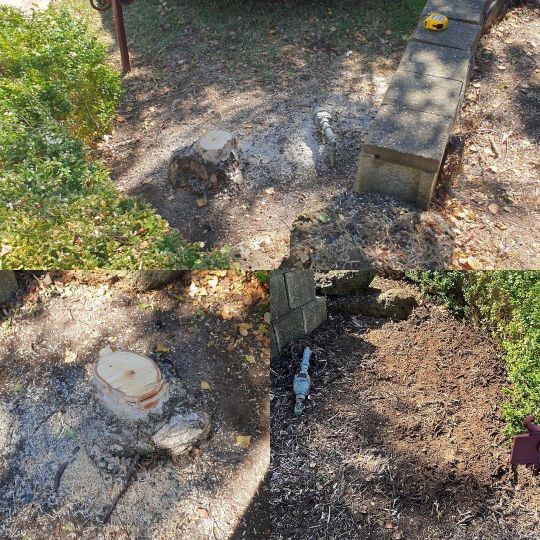
#propertycleanup #landscapeready #gardencleanups #gardencleanout #propertycleanout #gardencleanouts #treeremoval #stumpgrind #stumpgrinding #treecutting #arborists #excavation #excavator #excavationlife #excavators #excavationwork #fyp #stumps #paving #viral #hedges #pruning #retainingwalls concreting #concrete (at Chirnside Park, Victoria) https://www.instagram.com/p/CpoVUM5PvBD/?igshid=NGJjMDIxMWI=
#propertycleanup#landscapeready#gardencleanups#gardencleanout#propertycleanout#gardencleanouts#treeremoval#stumpgrind#stumpgrinding#treecutting#arborists#excavation#excavator#excavationlife#excavators#excavationwork#fyp#stumps#paving#viral#hedges#pruning#retainingwalls#concrete
1 note
·
View note
Text
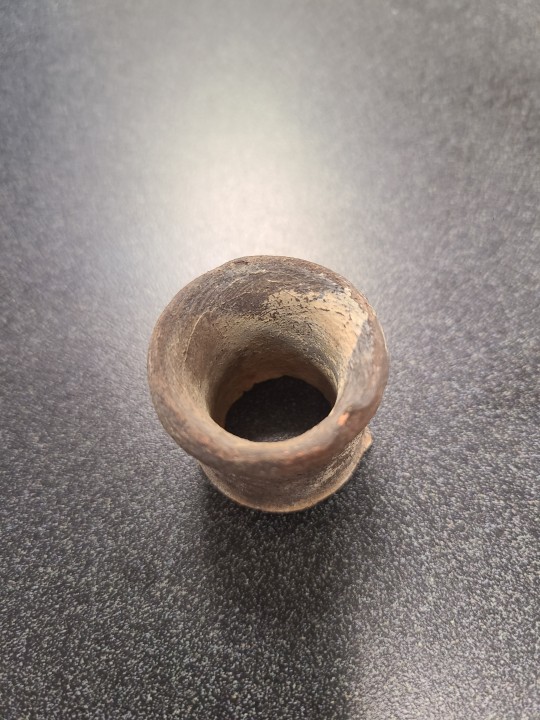
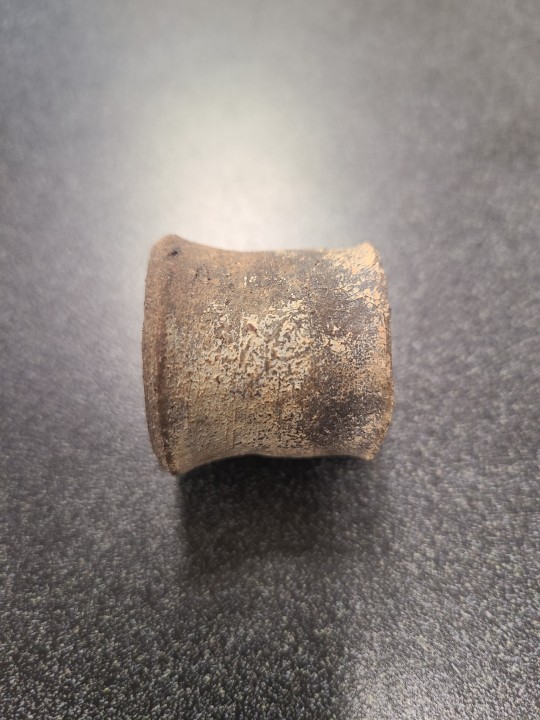
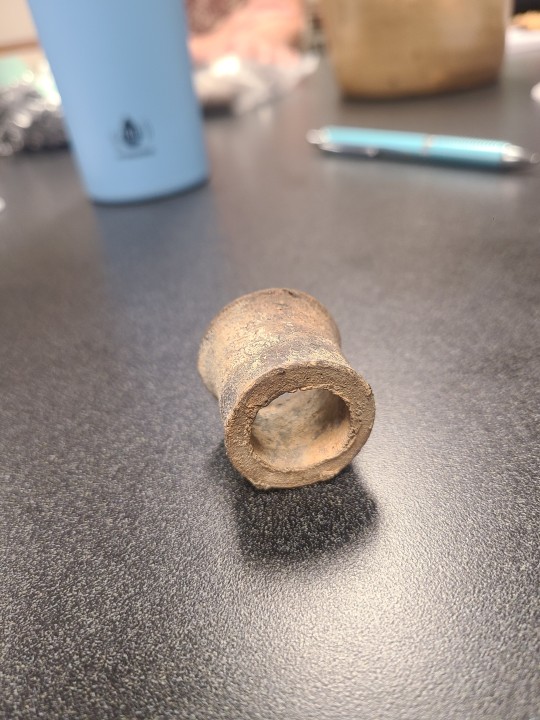
Hello archaeologists of Tumblr! I'm currently doing my first field school, and the dig we're working on is a historic stoneware pottery workshop from the 1800s in northwest Arkansas. I got permission from my site director to share and reach out about these odd little pieces we've been finding there.
They are little stoneware cylindrical rings varying about 2-3cm in size, with a finished rim on one end, while the other end is roughly but deliberately cut in some way. The way this cut is done varies by piece, from wire cutting done before firing, to saw cutting after firing, to a sort of twisting snap. We're not sure what exactly they are! It doesn't make much sense for them to be miscellaneous discard because there are DOZENS of them scattered across the site. Some are in the groundhog-style kiln we are excavating, some are scattered around the kiln and in other areas. A bunch of them were found near the firebox.
The other professionals on site are kind of stumped as to what they could be. Apparently there isn't anything like it in their background research. They've entertained a few theories, including kiln furniture (though they're too delicately made compared to the other kiln furniture we've seen), spouts meant to be put in gourds, connectors for pipes, and even little sapling pots (there was a big apple industry in the area at the time). We haven't found any in-situ to definitively tell what they are for. There's just LOTS of them lol
Any ideas would be appreciated! Might be a fun little community exercise
#archaeology#historical archaeology#archaeologist#19th century stoneware#pottery#I dunno what else to tag this tbh
14 notes
·
View notes